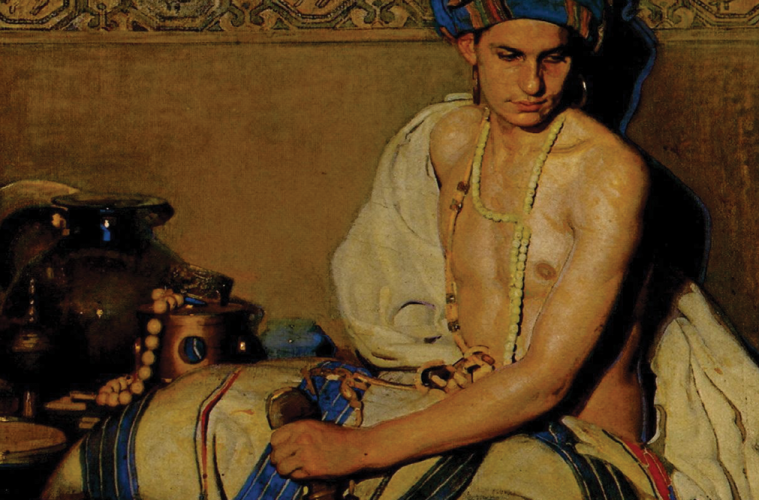Translated by Joseph Poladoghly
Many archaeological sites in the Middle East actually have their own queer histories and markers. Musa Shadeedi, a queer historian, writer and researcher, visited a number of sites to research these histories in what became a process of “queer unearthing.” Partnered with Berwaz Project, a queer feminist visual project, this excavatory work was converted into a map that allows viewers to visualize these sites.
Below is an account of five sites reconsidered.
The Temple of Heracles
Built in 166 AD, this Roman temple is dedicated to Heracles, the protector of the city. The pillars that remain stand proudly in the citadel at the heart of the capital city, Amman, towering over the surrounding areas.
According to the Greek philosopher and historian Plutarch, Heracles had countless male lovers1, but one in particular became important: Iolaus, who helped him kill Hydra. Each time Heracles cut off a head, two would grow in its place, making the task nearly impossible until Iolaus came in to cauterize the neck that Heracles had just severed so it could not generate new heads.
Iolaus’s tomb in Thebes (Luxor) became a destination for male lovers to break vows2.
The Temple of Artemis
Completed in 150 AD and lying at the heart of the historical city of Jerash, this Roman temple built for Artemis was regarded by Romans as the divine protector of the city and the goddess of fishing and fertility.
Artemis is believed to have lived in the wilderness among a group of virgin nymphs. According to myth, Artemis would murder the men who had stolen glances at her while bathing or attemting to seduce the nymphs3. This was not only due simply to her hatred of men, but also for retribution. According to the Roman poet Ovid, Zeus disguised himself as Artemis when he tried to rape Callisto, one of her nymphs, suggestion that Artemis had already had a relationship with them4.
The Arch of Hadrian
Also known as “Qaous al-Nasr” (Arch of Victory), this arch was built in 129 AD in the historical city of Jerash in honor of the emperor Hadrian, the first Roman emperor to openly express his love for men.
Hadrian married Sabina, the daughter of the previous Roman emperor, Trajan, for political reasons; their marriage was miserable and childless. Hadrian fell in love with Antinous, a handsome Greek youth who appeared next to him wherever they went. After Antinous drowned in the Nile for an unknown reason, Hadrian built an Egyptan city in his name (Antinoöpolis) out of grief5.
Quseir Amra
This Amoy desert castle and bathhouse was built between 723 and 743 AD under the auspices of the eleventh Umayyad caliph Walid Ibn Yazid Bin Abd al-Malik (Walid II). The walls are decorated with figures of plants, animals, mythological creatures, musicians, dancers, fishermen, writers, and pagan as well as Christian symbols. Even the dome of the bathhouse was designed with figures of constellations6.
The imam, historian, and Hadith expert, Shamseddine Ad-Dhazabi (1274–1348), claimed that “Walid’s blasphemy and godlessness was not right; he was known for wine-drinking and sodomy.”7 On the day of Walid II’s assassination, his brother Suleiman said, “There was much lewdness in his wine-drinking, he used to confess his desires publicly and even made sexual advances towards me.”
Shobak Castle
This Crusader castle was built by Baldwin I of Jerusalem in 1115 AD, making it the oldest Crusader castle in Jordan. Its name, Montreal, means Royal Mountain8.
William of Tyre, historian of the Crusades, archbishop, and King Baldwin IV’s advisor, wrote that King Baldwin I suffered from “a weakness of flesh” and that very few of his “body servants” knew9. Expanded upon elsewhere, historian Jonathan Philips stated that King Baldwin regarded women as “useful sources of financial and political advancement but little else,”10 suggesting the king’s lack of sexual interest in them, and historian Christopher Tyerman claimed that: “[Baldwin] was probably a homosexual, one of his more exotic intimates being a converted Muslim who later tried to betray him during the siege of Sidon.”11
Also of interest is that King Baldwin I’s cousin and successor to the thrown, King Baldwin II, signed a canon of the Council of Nablus issued to burn all those who practiced sodomy in the Kingdom of Jerusalem. Among the first written laws of the kingdom, this canon was the very first of its kind in the Medieval period, as was another that criminalized sexual engagements between Crusaders and Muslims.
You can download a PDF version of the map here

- Christopher Harrity, “The Golden Age of Denial: Hercules, the Bisexual Demigod,” Advocate, August 14, 2013, https://www.advocate.com.
- Louis Crompton, Homosexuality and Civilization (Cambridge, MA: Harvard University Press, 2003), 123.
- Louis Crompton, Homosexuality and Civilization (Cambridge, MA: Harvard University Press, 2003), 123.
- Siobhan, “Artemis Is the Queer Girl Goddess BFF of Your Dreams,” Autostraddle, May 4, 2017, https://www.autostraddle.com.
- Arifa Akbar, “Hadrian the Gay Emperor,” The Independent, October 22, 2011, https://www.independent.co.uk..
- “Qusayr ‘Amra,” World Monuments Fund, n.d., https://www.wmf.org/project/qusayr-amra.
- Jalaluddin Al-Suyuti. The History of the Caliphs (Beirut: Dar Ibn Hazem, 2003), 199.
- “Shobak Castle ‘Krak De Montreal, Crusader Castle,’” Jordan Experience, n.d., https://jordanexperience.com/shobak-castle-krak-de-montreal-crusader-castle/.
- Susan B. Edgington. Baldwin I of Jerusalem, 1100-1118. (New York: Routledge, 2019), 181.
- Jonathan Phillips, Holy Warriors: A Modern History of the Crusades, (Longon: Random House, 2010), 51.
- Christopher Tyerman. God’s War: A New History of the Crusades, (Cambridge: Harvard University Press, 2006) 202.

